- Privacy Policy

Home » Research Methodology – Types, Examples and writing Guide

Research Methodology – Types, Examples and writing Guide
Table of Contents
Research methodology is the backbone of any scientific or academic study, outlining the specific strategies and tools used to collect, analyze, and interpret data. A well-defined research methodology ensures that a study is conducted systematically, yielding reliable and valid results. This article explores the concept of research methodology, its various types, practical examples, and a step-by-step guide to writing a methodology section.

Research Methodology
Research methodology refers to the systematic plan and approach employed in a study to answer research questions or test hypotheses. It defines the tools, techniques, and procedures used to collect and analyze data, ensuring the research is structured and replicable.
For example, a study exploring the impact of remote learning on student performance might use surveys to collect data and statistical analysis to evaluate the findings.
Importance of Research Methodology
- Clarity and Focus: Provides a clear roadmap for the study, ensuring alignment with research objectives.
- Reliability: Ensures the study’s results can be replicated and trusted.
- Validity: Confirms that the methods used are appropriate for answering the research questions.
- Transparency: Allows others to evaluate the study’s credibility and rigor.
- Adaptability: Enables adjustments to the research process if unforeseen challenges arise.
Research Methodology Structure
1. introduction.
The introduction provides an overview of the research methodology, explaining its purpose and relevance to the study. It briefly outlines the chosen approach (qualitative, quantitative, or mixed methods) and justifies its suitability for addressing the research questions or hypotheses.
- Example: “This research employs a mixed-methods approach to explore the impact of remote work on employee productivity, combining quantitative surveys and qualitative interviews to gain a comprehensive understanding of the phenomenon.”
2. Research Design
This section describes the overall framework or design of the study. Common research designs include experimental, descriptive, correlational, or exploratory. The design should align with the research objectives and questions.
- Type of design (e.g., experimental, case study, longitudinal).
- Justification for the selected design.
- Example: “A descriptive research design was chosen to investigate patterns of online shopping behavior among millennials during the pandemic.”
3. Data Collection Methods
Detail the methods and tools used to gather data. This includes the type of data (primary or secondary) and the specific techniques employed.
- Data sources (e.g., surveys, interviews, observations, archival records).
- Instruments or tools used (e.g., questionnaires, scales, software).
- Procedures for data collection.
- Example: “Primary data was collected through structured questionnaires distributed online, while secondary data was sourced from industry reports and previous research studies.”
4. Sampling
Explain the sampling method used to select participants or data points for the study. Include the sample size, criteria for inclusion or exclusion, and sampling technique.
- Sampling population.
- Sampling technique (e.g., random, stratified, purposive).
- Rationale for the chosen sample size.
- Example: “A stratified random sampling method was employed to ensure representation across age groups. The final sample comprised 200 participants aged 18–60.”
5. Data Analysis Techniques
Describe the techniques or tools used to analyze the collected data. This section should differentiate between qualitative and quantitative data analysis methods.
- Quantitative analysis: statistical tools (e.g., SPSS, regression analysis).
- Qualitative analysis: thematic analysis, coding, or content analysis.
- Software or tools used (e.g., NVivo, Excel, Python).
- Example: “Quantitative data was analyzed using SPSS software for descriptive and inferential statistics, while qualitative data was thematically coded using NVivo to identify recurring patterns.”
6. Ethical Considerations
Discuss the ethical measures taken to ensure participant safety and data integrity. Ethical considerations reflect the study’s adherence to moral and professional standards.
- Informed consent from participants.
- Confidentiality and data security.
- Approval from an institutional review board (IRB).
- Example: “All participants provided informed consent, and their anonymity was ensured by assigning unique identification codes. The study was approved by the Institutional Review Board (IRB) at XYZ University.”
7. Limitations of the Methodology
Acknowledge any methodological limitations that may affect the validity or reliability of the results.
- Constraints such as sample size, geographic scope, or time frame.
- Potential biases or challenges.
- Example: “The study’s primary limitation was the reliance on self-reported data, which may be subject to response bias.”
8. Justification of Methodology
Provide a rationale for choosing specific methods and tools over alternatives. This reinforces the credibility of the methodology and its alignment with research objectives.
- Explanation of why chosen methods are appropriate.
- Comparison with other possible methods.
- Example: “The mixed-methods approach was selected to capture both numerical trends and in-depth personal experiences, ensuring a holistic understanding of the research problem.”
9. Operational Definitions (Optional)
Define key terms or concepts used in the study to ensure clarity and consistency.
Example: “For this study, ‘remote work productivity’ refers to the number of tasks completed within standard working hours, as self-reported by participants.”
Types of Research Methodology
1. qualitative research methodology.
Qualitative methodology focuses on understanding human experiences, behaviors, and social phenomena. It uses non-numerical data and is often exploratory.
- Subjective and descriptive.
- Data collected through interviews, focus groups, or observations.
- Analyzes themes, patterns, and narratives.
- Example: A study exploring teachers’ perceptions of remote learning challenges during the COVID-19 pandemic.
2. Quantitative Research Methodology
Quantitative methodology focuses on measuring and analyzing numerical data to test hypotheses or answer research questions. It is often used for studies requiring statistical analysis.
- Objective and structured.
- Data collected through surveys, experiments, or secondary datasets.
- Statistical methods used for data analysis.
- Example: Examining the relationship between study hours and academic performance among high school students.
3. Mixed Methods Research Methodology
Mixed methods combine qualitative and quantitative approaches to provide a comprehensive understanding of a research problem.
- Integrates numerical data with detailed narratives.
- Offers both breadth and depth in analysis.
- Often uses sequential or concurrent designs.
- Example: Investigating how healthcare workers perceive telemedicine (qualitative) and evaluating patient satisfaction scores (quantitative).
4. Descriptive Research Methodology
Descriptive research aims to describe characteristics, phenomena, or trends in a specific population or setting.
- Non-experimental.
- Data collected through surveys, case studies, or observations.
- Focuses on “what” rather than “why” or “how.”
- Example: Surveying college students to understand their preferred learning platforms.
5. Experimental Research Methodology
Experimental research investigates cause-and-effect relationships by manipulating variables and observing outcomes.
- Involves control and experimental groups.
- Uses randomization to reduce bias.
- Common in natural and social sciences.
- Example: Testing the effectiveness of a new drug on reducing symptoms compared to a placebo.
6. Correlational Research Methodology
Correlational research examines the relationship between two or more variables without manipulating them.
- Identifies positive, negative, or no correlation.
- Cannot establish causation.
- Data often collected through surveys or secondary datasets.
- Example: Analyzing the correlation between screen time and sleep quality among teenagers.
Examples of Research Methodology
1. education.
- Topic: The effectiveness of project-based learning on student engagement.
- Methodology: Mixed methods involving student surveys (quantitative) and teacher interviews (qualitative).
2. Healthcare
- Topic: The impact of physical activity on managing type 2 diabetes.
- Methodology: Quantitative approach using clinical trials to measure blood glucose levels.
3. Business
- Topic: Factors influencing employee job satisfaction in remote work environments.
- Methodology: Descriptive research using online surveys to collect data from employees across industries.
4. Environmental Studies
- Topic: The effect of urbanization on local biodiversity.
- Methodology: Descriptive research involving field observations and quantitative data analysis of species populations.
How to Write the Methodology Section
Step 1: provide an overview.
Begin by explaining the overall research approach (qualitative, quantitative, or mixed methods) and justifying its suitability for addressing the research questions.
- Example: “This study employs a mixed-methods approach to explore the impact of remote work on employee productivity. The combination of quantitative surveys and qualitative interviews provides a comprehensive understanding of the phenomenon.”
Step 2: Describe the Research Design
Outline the specific design used, such as experimental, descriptive, or correlational, and explain why it was chosen.
- Example: “A correlational design was selected to analyze the relationship between screen time and sleep quality among high school students.”
Step 3: Detail the Data Collection Methods
Explain how data was collected, including tools, instruments, and procedures.
- Example: “Data was collected using an online survey distributed to 500 participants. The survey included closed-ended questions measuring job satisfaction and open-ended questions capturing employee experiences.”
Step 4: Specify the Sampling Method
Describe the sampling strategy, including sample size, selection criteria, and sampling technique (e.g., random, stratified, convenience).
- Example: “A stratified sampling technique was employed to ensure representation across different age groups. The final sample included 200 respondents aged 18–60.”
Step 5: Describe Data Analysis Techniques
Explain the methods used to analyze the data, whether statistical or thematic.
- Example: “Quantitative data was analyzed using SPSS software, employing descriptive statistics and regression analysis. Qualitative data from interviews was thematically coded to identify patterns and themes.”
Step 6: Address Ethical Considerations
Discuss ethical measures such as informed consent, confidentiality, and data security.
- Example: “All participants provided informed consent, and data was anonymized to maintain confidentiality. Ethical approval was obtained from the institutional review board.”
Step 7: Justify Your Choices
Provide a rationale for selecting the chosen methods and explain their relevance to the research objectives.
- Example: “The use of surveys allowed for efficient data collection from a large sample, while interviews provided in-depth insights into individual experiences.”
Tips for Writing a Strong Methodology Section
- Be Detailed and Specific: Provide enough detail to allow replication of your study.
- Maintain Objectivity: Use neutral language and avoid subjective statements.
- Link to Objectives: Ensure all methods align with the study’s research questions or hypotheses.
- Use Subheadings: Organize the section into clear subsections for readability.
- Cite Sources: Reference any tools, instruments, or previous studies that informed your methodology.
Common Mistakes to Avoid
- Lack of Clarity: Ambiguous descriptions can confuse readers and undermine credibility.
- Insufficient Detail: Omitting key steps or procedures can make the study irreproducible.
- Ignoring Limitations: Failing to acknowledge methodological limitations reduces transparency.
- Misalignment with Objectives: Methods that do not address the research questions weaken the study’s validity.
The research methodology is a vital component of any study, laying the foundation for credible and reliable results. By selecting the appropriate type—whether qualitative, quantitative, or mixed methods—and providing a clear, detailed explanation of the processes involved, researchers can ensure that their work is both rigorous and replicable. Following the writing guide and addressing common mistakes will help create a robust methodology section, contributing to the overall strength and impact of the research.
- Creswell, J. W. (2018). Research Design: Qualitative, Quantitative, and Mixed Methods Approaches . Sage Publications.
- Babbie, E. (2020). The Practice of Social Research . Cengage Learning.
- Bryman, A. (2016). Social Research Methods . Oxford University Press.
- Patton, M. Q. (2015). Qualitative Research & Evaluation Methods: Integrating Theory and Practice . Sage Publications.
- Flick, U. (2018). An Introduction to Qualitative Research . Sage Publications.
About the author
Muhammad Hassan
Researcher, Academic Writer, Web developer
You may also like

Research Paper – Structure, Examples and Writing...

Research Paper Conclusion – Writing Guide and...

Scope of the Research – Writing Guide and...


References in Research – Types, Examples and...

Dissertation Methodology – Structure, Example...

Purpose of Research – Objectives and Applications
- How it works
"Christmas Offer"
Terms & conditions.
As the Christmas season is upon us, we find ourselves reflecting on the past year and those who we have helped to shape their future. It’s been quite a year for us all! The end of the year brings no greater joy than the opportunity to express to you Christmas greetings and good wishes.
At this special time of year, Research Prospect brings joyful discount of 10% on all its services. May your Christmas and New Year be filled with joy.
We are looking back with appreciation for your loyalty and looking forward to moving into the New Year together.
"Claim this offer"
In unfamiliar and hard times, we have stuck by you. This Christmas, Research Prospect brings you all the joy with exciting discount of 10% on all its services.
Offer valid till 5-1-2024
We love being your partner in success. We know you have been working hard lately, take a break this holiday season to spend time with your loved ones while we make sure you succeed in your academics
Discount code: RP0996Y

Your content here...

Chapter 3 – Dissertation Methodology (example)
Disclaimer: This is not a sample of our professional work. The paper has been produced by a student. You can view samples of our work here . Opinions, suggestions, recommendations and results in this piece are those of the author and should not be taken as our company views.
Type of Academic Paper – Dissertation Chapter
Academic Subject – Marketing
Word Count – 3017 words
Introduction
The current chapter presents developing the research methods needed to complete the experimentation portion of the current study. The chapter will discuss in detail the various stages of developing the methodology of the current study. This includes a detailed discussion of the philosophical background of the research method chosen. In addition to this, the chapter describes the data collection strategy, including the selection of research instrumentation and sampling. The chapter closes with a discussion on the analysis tools used to analyse the data collected.
Selecting an Appropriate Research Approach
Creswall (2013) stated that research approaches are plans and procedures that range from steps, including making broad assumptions to detailed methods of data collection, analysis, and interpretation. The several decisions involved in the process are used to decide which approach should be used in a specific study that is informed using philosophical assumptions brought to the study (Creswall 2013). Included in this are procedures of inquiry or research designs and specific research methods used for data collection, its analysis, and finally, its interpretation. However, Guetterman (2015); Lewis (2015); and Creswall (2013) argue that the selection of the specific research approach is based on the nature of the research problem, or the issue that is being addressed by any study, personal experiences of the researchers’, and even the audience for which the study is being developed for.
There are many ways to customise research approaches to develop an approach most suited for a particular study. However, the main three categories with which research approaches are organised include; qualitative, quantitative, and mixed research methods. Creswall (2013) comments that all three approaches are not considered so discrete or distinct from one another. Creswall (2013) states, “qualitative and quantitative approaches should not be viewed as rigid, distinct categories, polar opposite, or dichotomies” (p.32). Newmand and Benz (1998) pointed out that quantitative and qualitative approaches instead represent different ends on a continuum since a study “tends” to be more quantitative than qualitative or vice versa. Lastly, mixed methods research resides in the middle of the continuum as it can incorporate elements and characteristics of both quantitative and qualitative approaches. Lewis (2015) points out that the main distinction that is often cited between quantitative and qualitative research is that it is framed in terms of using numbers rather than words; or using closed-ended questions for quantitative hypotheses over open-ended questions for qualitative interview questions. Guetterman (2015) points out that a clearer way of viewing gradations of differences between the approaches is to examine the basic philosophical assumptions brought to the study, the kinds of research strategies used, and the particular methods implemented in conducting the strategies.
Underlying Philosophical Assumptions
An important component of defining the research approach involves philosophical assumptions that contribute to the broad research approach of planning or proposing to conduct research. It involves the intersection of philosophy, research designs and specific methods as illustrated in Fig. 1 below.
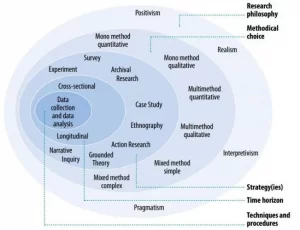
Figure 3.2-1- Research Onion (Source; Saunders and Tosey 2013)
Slife and Williams (1995) have argued that philosophical ideas have remained hidden within the research. However, they still play an influential role in the research practice, and it is for this reason that it is most identified. Various philosophical assumptions are used to construct or develop a study. Saunders et al. (2009) define research philosophy as a belief about how data about a phenomenon should be gathered, analysed and used. Saunders et al. (2009) identify common research philosophies such as positivism, realism, interpretivism, subjectivism, and pragmatism. Dumke (2002) believes that two views, positivism and phenomenology, mainly characterise research philosophy.
Positivism reflects acceptance in adopting the philosophical stance of natural scientists (Saunders, 2003). According to Remenyi et al. (1998), there is a greater preference in working with an “observable social reality” and that the outcome of such research can be “law-like” generalisations that are the same as those which are produced by physical and natural scientists. Gill and Johnson (1997) add that it will also emphasise a high structure methodology to allow for replication for other studies. Dumke (2002) agrees and explains
that a positivist philosophical assumption produces highly structured methodologies and allows for generalisation and quantification of objectives that can be evaluated by statistical methods. For this philosophical approach, the researcher is considered an objective observer who should not be impacted by or impact the subject of research.
On the other hand, more phenomenological approaches agree that the social world of business and management is too complex to develop theories and laws similar to natural sciences. Saunders et al. (2000) argue that this is the reason why reducing observations in the real world to simple laws and generalisations produces a sense of reality which is a bit superficial and doesn’t present the complexity of it.
The current study chooses positivistic assumptions due to the literature review’s discussion of the importance of Big Data in industrial domains and the need for measuring its success in the operations of the business. The current study aims to examine the impact that Big Data has on automobile companies’ operations. To identify a positive relationship between Big Data usage and beneficial business outcomes, the theory needs to be used to generate hypotheses that can later be tested of the relationship which would allow for explanations of laws that can later be assessed (Bryman and Bell, 2015).
Selecting Interpretive Research Approach
Interpretive research approaches are derived from the research philosophy that is adopted. According to Dumke (2002), the two main research approaches are deductive and inductive. The inductive approach is commonly referred to when theory is derived from observations. Thus, the research begins with specific observations and measures. It is then from detecting some pattern that a hypothesis is developed. Dumke (2002) argues that researchers who use an inductive approach usually work with qualitative data and apply various methods to gather specific information that places different views. From the philosophical assumptions discussed in the previous section, it is reasonable to use the deductive approach for the current study. It is also considered the most commonly used theory to establish a relationship between theory and research. The figure below illustrates the steps used for the process of deduction.
Data Collection
- confirmed or rejected
- Revision of theory
Based on what is known about a specific domain, the theoretical considerations encompassing it a hypothesis or hypotheses are deduced that will later be subjected to empirical enquiry (Daum, 2013). Through these hypotheses, concepts of the subject of interest will be translated into entities that are rational for a study. Researchers are then able to deduce their hypotheses and convert them into operational terms.
Hire an Expert Dissertation Chapter Writer
Orders completed by our expert writers are
- Formally drafted in an academic style
- Free Amendments and 100% Plagiarism Free – or your money back!
- 100% Confidential and Timely Delivery!
- Free anti-plagiarism report
- Appreciated by thousands of clients. Check client reviews

Justifying the Use of Quantitative Research Method
Saunders (2003) notes that almost all research will involve some numerical data or even contain data quantified to help a researcher answer their research questions and meet the study’s objectives. However, quantitative data refers to all data that can be a product of all research strategies (Bryman and Bell, 2015; Guetterman, 2015; Lewis, 2015; Saunders, 2003). Based on the philosophical assumptions and interpretive research approach, a quantitative research method is the best suited for the current study. Haq (2014) explains that quantitative research is about collecting numerical data and then analysing it through statistical methods to explain a specific phenomenon. Mujis (2010) defends the use of quantitative research because, unlike qualitative research, which argues that there is no pre-existing reality, quantitative assumes that there is only a single reality about social conditions that researchers cannot influence in any way. Also, qualitative research is commonly used when there is little to no knowledge of a phenomenon, whereas quantitative research is used to find the cause and effect relationship between variables to either verify or nullify some theory or hypothesis (Creswall 2002; Feilzer 2010; Teddlie and Tashakkori 2012).
Selecting an Appropriate Research Strategy
There are many strategies available to implement in a study, as evidenced from Fig. 1. There are many mono-quantitative methods, such as telephone interviews, web-based surveys, postal surveys, and structured questionnaires (Haq 2014). Each instrument has its own pros and cons in terms of quality, time, and data cost. Brymand (2006); Driscoll et al. (2007); Edwards et al. (2002); and Newby et al. (2003) note that most researchers use structured questionnaires for data collection they are unable to control or influence respondents, which leads to low response rates but more accurate data obtained. Saunders and Tosey (2015) have argued that quantitative data is simpler to obtain and more concise to present. Therefore, the current study uses a survey-based questionnaire (See Appendix A).
Justifying the use of Survey Based Questionnaire
Surveys are considered the most traditional forms of research and are used in non-experimental descriptive designs that describe some reality. Survey-based questionnaires are often restricted to a representative sample of a potential group of the study’s interest. In this case, it is the executives currently working for automobile companies in the UK. The survey instrument is then chosen for its effectiveness at being practical and inexpensive (Kelley et al., 2003). Due to the philosophical assumptions, interpretive approach, and methodological approach, the survey design for the current study is considered the best instrument in line with these premises, besides being cost-effective.
Empirical Research Methodology
Research design.
This section describes how research is designed to use the techniques used for data collection, sampling strategy, and data analysis for a quantitative method. Before going into the strategies of data collection and analysis, a set of hypotheses were developed.
Hypotheses Development
The current study uses a quantitative research approach, making it essential to develop a set of hypotheses that will be used as a test standard for the mono-method quantitative design. The following are a set of hypotheses that have been developed from the examination of the literature review.
H1- The greater the company’s budget for Big Data initiatives (More than 1 million GBP), the greater its ability to monetise and generate new revenues.
H2- The greater the company’s budget for Big Data initiatives (More than 1 million GBP) the more decrease in expenses in found.
H3- The greatest impact of Big Data on a company is changing the way business is done.
H4- Big Data integrating with a company has resulted in competitive significance.
H5- The analytical abilities of a company allows for achieved measurable results.
H6- Investing in Big Data will lead to highly successful business results.
H7- A business’s operations function is fuelling Big Data initiatives and effecting change in operations.
H8- The implementation of Big Data in the company has positive impacts on business.
This section includes the sampling method used to collect the number of respondents needed to provide information, then analysed after collection.
Sampling Method
Collis (2009) explains that there are many kinds of sampling methods that can be used for creating a specific target sample from a population. This current study uses simple random sampling to acquire respondents with which the survey will be conducted. Simple random sampling is considered the most basic form of probability sampling. Under the method, elements are taken from the population at random, with all elements having an equal chance of being selected. According to () as of 2014, there are about thirty-five active British car manufacturers in the UK, each having an employee population of 150 or more. This is why the total population of employees in car manufacturers is estimated to be 5,250 employees. The sample, therefore, developed used the following equation;
2 × (1 − )
+( 2 × (1− ) ) 2
Where; N is the population size, e is the margin of error (as a decimal), z is confidence level (as a z-score), and p is percentage value (as a decimal). Thus, the sample size is with a normal distribution of 50%. With the above equation, a population of 5,250; with a 95% confidence level and 5% margin of error, the total sample size needed for the current equals 300. Therefore, N=300, which is the sample size of the current study.
The survey develops (see Appendix A) has a total of three sections, A, B, and C, with a total of 39 questions. Each section has its own set of questions to accomplish. The survey is a mix of closed-end questions that look to comprehend the respondents’ demographic makeup, the Big Data initiatives of the company, and the impact that Big Data was having on their company. The survey is designed to take no longer than twenty minutes. The survey was constructed on Survey Monkey.com, and an online survey provided website. The survey was left on the website for a duration of 40 days to ensure that the maximum number of respondents were able to answer the survey. The only way that the survey was allowed for a respondent is if they passed a security question as if they were working for an automobile company in the UK when taking the survey. Gupta et al. (2004) believe that web surveys are visual stimuli, and the respondent has complete control about whether or how each question is read and understood. That is why Dillman (2000) argued that web questionnaires are expected to resemble those taken through the mail/postal services closely.
Data Analysis
The collected data is then analysed through the Statistical Package for Social Science (SPSS) version 24 for descriptive analysis. The demographic section of the survey will be analysed using descriptive statistics. Further analysis of the data includes regression analysis. Simple regression analysis includes only one independent variable and one dependent variable. Farrar and Glauber (1967) assert that the purpose of regression analysis is to estimate the parameters of dependency, and it should not be used to determine the interdependency of a relationship.
Need a Dissertation Chapter On a Similar Topic?
Conclusions.
The chapter provides a descriptive and in-depth discussion of the methods involved in the current study’s research. The current study is looking towards a quantitative approach that considers positivism as its philosophical undertaking, using deductive reasoning for its interpretive approach, is a mono-quantitative method that involves the use of a survey instrument for data collection. The methodology chapter also provided the data analysis technique, which is descriptive statistics through frequency analysis and regression analysis.
Examples of results;
Question 8- Of these staff, are mostly working in or for your consumer-facing (B2C) businesses, your commercial or wholesale (B2B) businesses, or both?
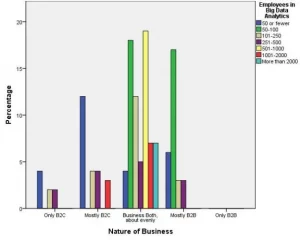
Based on the illustration, nineteen (19) respondents indicated that 501-1000 employees are dedicated to analytics for both B2B and B2C. The category of using Big Data analytics for both B2B and B2C comprises the most agreement of respondents with 72 of 132 indicated.
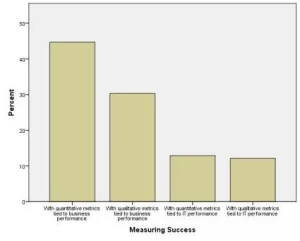
The figure above represents the respondents’ answers to their automobile company’s plan for measuring Big Data’s success. Of the 132 participants, 44.70 per cent responded that the company is planning on using quantitative metrics associated with business performance to analyse if Big Data is actually successful. Another, 30.30 per cent indicated that their company was planning on using qualitative metrics tied to business performance. Using business performance to analyse the success of Big Data is coherent to the results of the literature review that indicated previous studies of doing such. As an automobile company, they need to know the results of using Big Data analytics, and that is only by using business performance indicators regardless of being qualitative or quantitative.
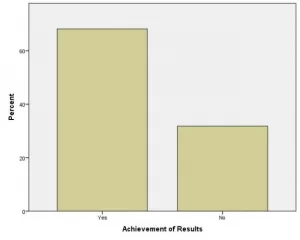
Fig. 4.3-6 portrays the response of participants in regards to actually achieving measurable results from Big Data. According to 68.18 per cent of respondents, the company that they worked for did indeed show measurable results from their investments in Big Data. However, 31.82 per cent indicated that there was indeed no measurable result in investing in Big Data.
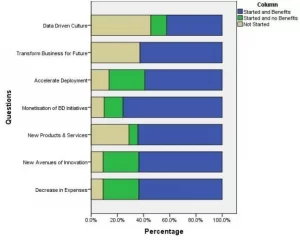
Bryman, A., Bell, E., 2015. Business Research Methods. Oxford University Press.
Daum, P., 2013. International Synergy Management: A Strategic Approach for Raising Efficiencies in the Cross-border Interaction Process. Anchor Academic Publishing (aap_verlag).
Dümke, R., 2002. Corporate Reputation and its Importance for Business Success: A European
Perspective and its Implication for Public Relations Consultancies. diplom.de.
Guetterman, T.C., 2015. Descriptions of Sampling Practices Within Five Approaches to Qualitative Research in Education and the Health Sciences. Forum Qualitative Sozialforschung /
Forum: Qualitative Social Research 16.
Haq, M., 2014. A Comparative Analysis of Qualitative and Quantitative Research Methods and a Justification for Adopting Mixed Methods in Social Research (PDF Download Available).
ResearchGate 1–22. doi:http://dx.doi.org/10.13140/RG.2.1.1945.8640
Kelley, K., Clark, B., Brown, V., Sitzia, J., 2003. Good practice in the conduct and reporting of survey research. Int J Qual Health Care 15, 261–266. doi:10.1093/intqhc/mzg031
Lewis, S., 2015. Qualitative Inquiry and Research Design: Choosing Among Five Approaches.
Health Promotion Practice 16, 473–475. doi:10.1177/1524839915580941
Saunders, M., 2003. Research Methods for Business Students. Pearson Education India.
Saunders, M.N.K., Tosey, P., 2015. Handbook of Research Methods on Human Resource
Development. Edward Elgar Publishing.
DMCA / Removal Request
If you are the original writer of this Dissertation Chapter and no longer wish to have it published on the www.ResearchProspect.com then please:
Request The Removal Of This Dissertation Chapter
Frequently Asked Questions
How to write methodology chapter of a dissertation.
To write the methodology chapter of a dissertation:
- Describe research design & approach.
- Explain data collection methods.
- Justify chosen methods.
- Address limitations.
- Analyse data.
- Ensure replicability.
As Featured On

USEFUL LINKS
LEARNING RESOURCES

COMPANY DETAILS

Splash Sol LLC
- How It Works

🚀 Work With Us
Private Coaching
Language Editing
Qualitative Coding
✨ Free Resources
Templates & Tools
Short Courses
Articles & Videos
Free Download
Methodology Template
The fastest (and smartest) way to craft a research methodology that communicates your design and earns you marks.
Available in Google Doc, Word & PDF format 4.9 star rating, 5000 + downloads

Step-by-step instructions
Tried & tested academic format
Fill-in-the-blanks simplicity
Pro tips, tricks and resources
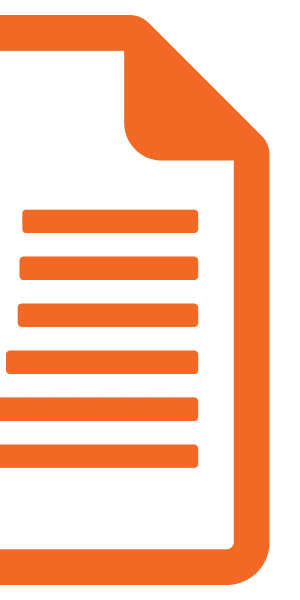
What It Covers
This template covers all the core components required in the methodology section of a typical dissertation, thesis or research paper, including:
- The opening section
- Research philosophy
- Research type
- Research strategy
- Time horizon
- Sampling strategy
- Data collection methods
- Data analysis methods
- Conclusion & summary
The purpose of each section is explained in plain language, along with practical examples to help you understand exactly what’s required.
The cleanly-formatted Google Doc can be downloaded as a fully editable MS Word Document (DOCX format), so you can use it as-is or convert it to LaTeX.
download your copy
100% Free to use. Instant access.
I agree to receive the free template and other useful resources.
Download Now (Instant Access)

FAQs: Research Methdodology Template
What format is the template (doc, pdf, ppt, etc.).
The methodology chapter template is provided as a Google Doc. You can download it in MS Word format or make a copy to your Google Drive. You’re also welcome to convert it to whatever format works best for you, such as LaTeX or PDF.
What types of dissertations/theses can this template be used for?
The methodology template follows the standard format for academic research projects, which means it will be suitable for the vast majority of dissertations and theses (especially those within the sciences), whether they adopt a qualitative, quantitative, or mixed-methods approach. The template is loosely based on Saunders’ research onion , which is recommended as a methodological framework by many universities.
Keep in mind that the exact requirements for the methodology chapter/section will vary between universities and degree programs. These are typically minor, but it’s always a good idea to double-check your university’s requirements before you finalize your structure.
Is this template for an undergrad, Master or PhD-level thesis?
This template can be used for a dissertation, thesis or research project at any level of study. Doctoral-level projects typically require the methodology chapter to be more extensive/comprehensive, but the structure will typically remain the same.
How long should the methodology chapter be?
This can vary a fair deal, depending on the level of study (undergrad, Master or Doctoral), the field of research, as well as your university’s specific requirements. Therefore, it’s best to check with your university or review past dissertations from your program to get an accurate estimate.
How detailed should my methodology be?
As a rule of thumb, you should provide enough detail for another researcher to replicate your study. This includes clear descriptions of procedures, tools, and techniques you used to collect and analyse your data, as well as your sampling approach.
How technical should my language be in this chapter?
In the methodology chapter, your language should be technical enough to accurately convey your research methods and processes, but also clear and precise to ensure it’s accessible to readers within your field.
Aim for a balance where the technical aspects of your methods are thoroughly explained without overusing jargon or overly complex language.
Should I include a pilot study in my methodology?
If you conducted a pilot study, you can include it in the methodology to demonstrate the feasibility and refinement of your methods. Be sure to obtain the necessary permissions from your research advisor before conducting any pilot studies, though.
Can I share this template with my friends/colleagues?
Yes, you’re welcome to share this template in its original format (no editing allowed). If you want to post about it on your blog or social media, we kindly request that you reference this page as your source.
Do you have templates for the other chapters?
Yes, we do. We are constantly developing our collection of free resources to help students complete their dissertations and theses. You can view all of our template resources here .
Can Grad Coach help me with my methodology?
Yes, we can assist with your methodology chapter (or any other chapter) on a coaching basis. If you’re interested, feel free to get in touch to discuss our private coaching services .
Additional Resources
If you’re working on a research proposal, you’ll also want to check these out…
Methodology Bootcamp
1-On-1 Private Coaching
The Grad Coach YouTube Channel
The Grad Coach Podcast

IMAGES
COMMENTS
Mar 26, 2024 · The methodology section is a vital part of a dissertation, outlining the design, participants, data collection, data analysis, and ethical considerations. By following a structured approach, providing justifications for each choice, and ensuring clarity, you can write a robust methodology that supports the credibility and reliability of your ...
Methodological Choice #6 – Data Collection Method. Next up, you’ll need to explain how you’ll go about collecting the necessary data for your study. Your data collection method (or methods) will depend on the type of data that you plan to collect – in other words, qualitative or quantitative data.
The best place to find more examples of methodology chapters would be within dissertation/thesis databases. These databases include dissertations, theses and research projects that have successfully passed the assessment criteria for the respective university, meaning that you have at least some sort of quality assurance.
Aug 25, 2022 · Your research methodology discusses and explains the data collection and analysis methods you used in your research. A key part of your thesis, dissertation, or research paper, the methodology chapter explains what you did and how you did it, allowing readers to evaluate the reliability and validity of your research and your dissertation topic.
Mar 26, 2024 · Examples of Research Methodology 1. Education. Topic: The effectiveness of project-based learning on student engagement. Methodology: Mixed methods involving student surveys (quantitative) and teacher interviews (qualitative). 2. Healthcare. Topic: The impact of physical activity on managing type 2 diabetes.
This section includes the sampling method used to collect the number of respondents needed to provide information, then analysed after collection. Sampling Method. Collis (2009) explains that there are many kinds of sampling methods that can be used for creating a specific target sample from a population.
methodology can help increase the reader’s trust in your findings. First, we will define and differentiate quantitative and qualitative research. Then, for each of these types of research, we will look at the kinds of information that a methodology should provide. This handout has annotated examples of both quantitative and
introduce the method used (i.e. quantitative, qualitative, mixed-methods). Tip: Describe the specific methodology and how it connects to the research question(s). Outline the organization of the chapter. Restate the research questions presented in Chapter I. Justify the chosen research design.
The Methodology chapter is perhaps the part of a qualitative thesis that is most unlike its equivalent in a quantitative study. Students doing quantitative research have an established conventional ‘model’ to work to, which comprises these possible elements: Overview of the Experiment/Design Population/Sample Location
The methodology template follows the standard format for academic research projects, which means it will be suitable for the vast majority of dissertations and theses (especially those within the sciences), whether they adopt a qualitative, quantitative, or mixed-methods approach.